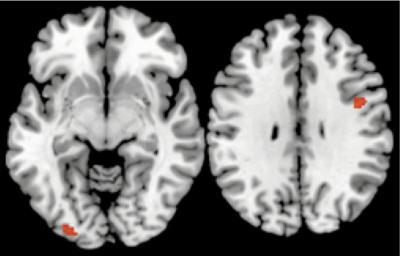How unconscious processing improves decision-making
February 15, 2013

New brain imaging research from Carnegie Mellon University found that the brain regions responsible for making decisions continue to be active even when the conscious brain is distracted with a different task. This image shows unconscious activity in two parts of the brain, the left visual cortex and right prefrontal cortex. (Credit: Carnegie Mellon University)
New brain imaging research from Carnegie Mellon University finds that the brain regions responsible for making decisions continue to be active even when the conscious brain is distracted with a different task.
The research provides some of the first evidence showing how the brain unconsciously processes decision information in ways that lead to improved decision-making.
“This research begins to chip away at the mystery of our unconscious brains and decision-making,” said J. David Creswell, assistant professor of psychology in CMU’s Dietrich College of Humanities and Social Sciences and director of the Health and Human Performance Laboratory.
“It shows that brain regions important for decision-making remain active even while our brains may be simultaneously engaged in unrelated tasks, such as thinking about a math problem. What’s most intriguing about this finding is that participants did not have any awareness that their brains were still working on the decision problem while they were engaged in an unrelated task.”
For the study, the researchers presented 27 healthy adults with information about cars and other items while undergoing neuroimaging. Then, before being asked to make decisions about the items, the participants had to complete a difficult distractor task — memorizing sequences of numbers — to prevent them from consciously thinking about the decision information.
The results included three main findings. First, the team confirmed previous research demonstrating that a brief period of distraction — in this case two minutes — produced higher quality decisions about the cars and other items.
But did this effect occur because the distraction period provided an opportunity for the brain to take a break from decision-making and then return to the problem with a fresh look? Or alternatively, does the brain continue to unconsciously process decision information during this distraction period? This research supports the latter unconscious processing explanation.
When the participants were initially learning information about the cars and other items, the neuroimaging results showed activation in the visual and prefrontal cortices, regions that are known to be responsible for learning and decision-making. Additionally, during the distractor task, both the visual and prefrontal cortices continued to be active — or reactivated — even though the brain was consciously focused on number memorization.
Third, the results showed that the amount of reactivation within the visual and prefrontal cortices during the distractor task predicted the degree to which participants made better decisions, such as picking the best car in the set.
“We all face difficult problems we need to solve on a regular basis,” Creswell said. “This study provides some of the first clues for how our brains process this information for effective problem-solving and decision-making.”
The Pittsburgh Life Sciences Greenhouse Opportunity Fund supported this research.